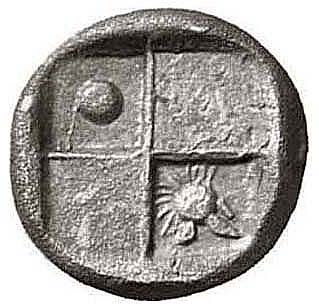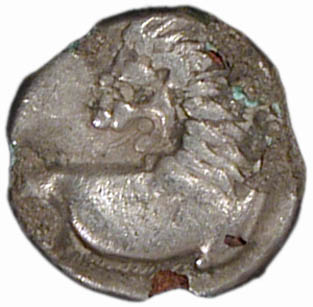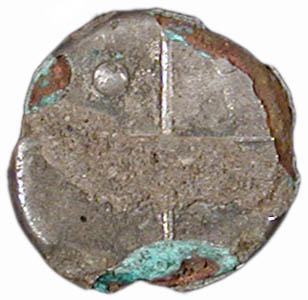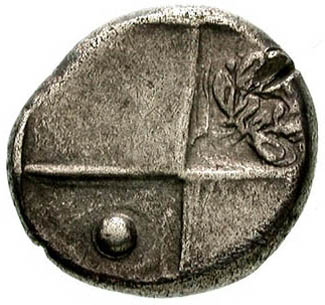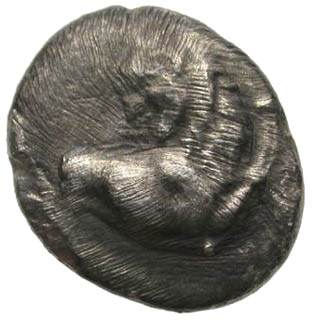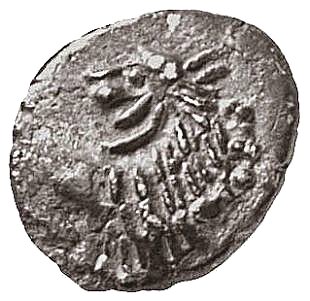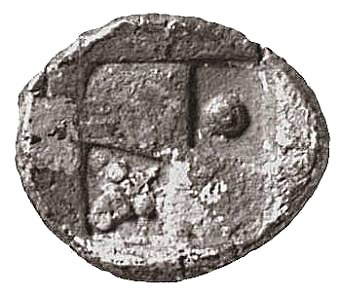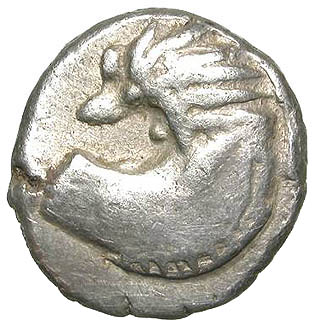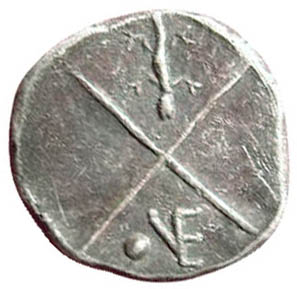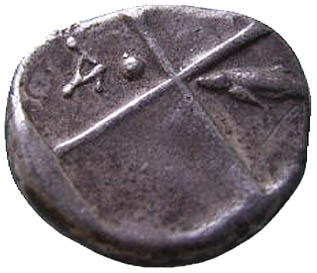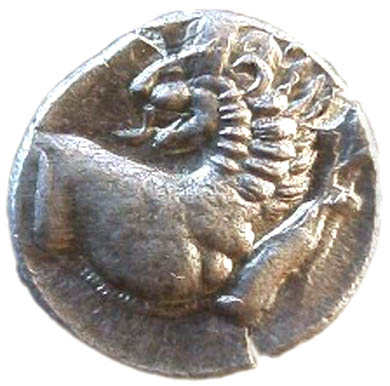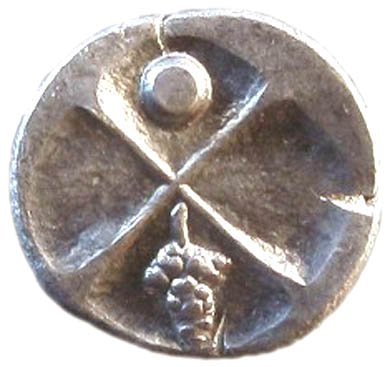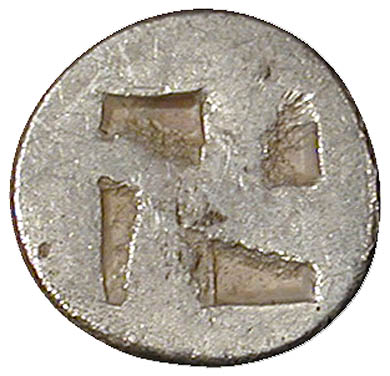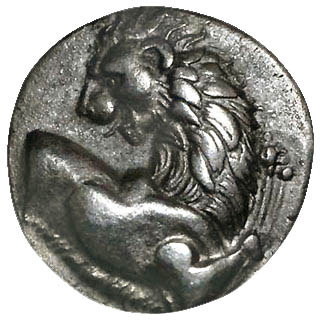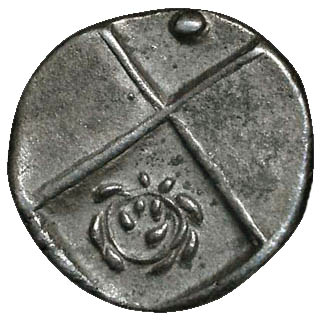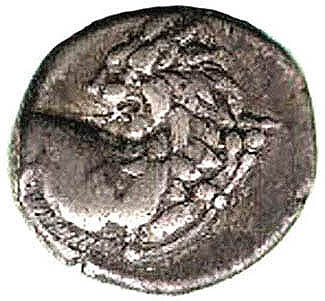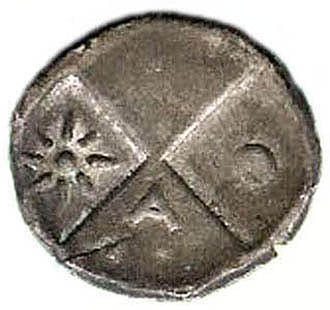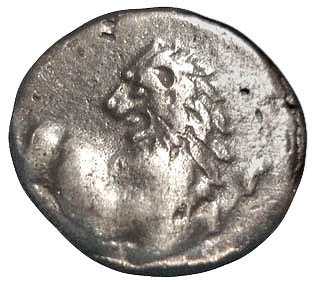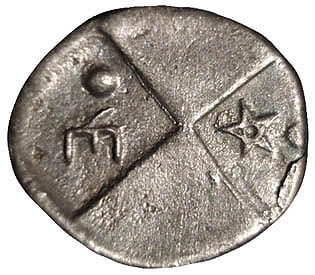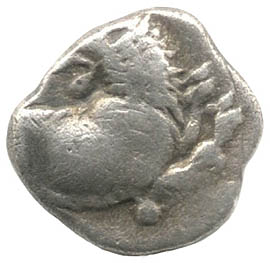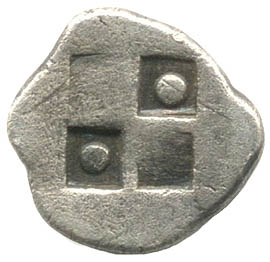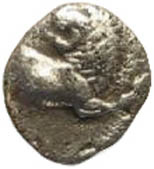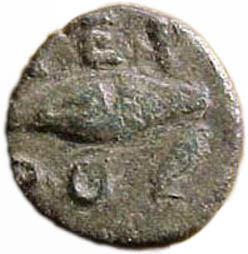|
|
|
||||
|
|
Cherronesos hemidrachm (2.11g), from Cherronesos, Thrace (present-day European Turkey), c. 400-350 BC, with reverse of pellet and crested Corinthian helmet, Sear Greek 1603v., SNG Berry 502 |
|
|||
|
|
|
|
|||
|
|
This coin from the Greek colony of Cherronesos is the single
most common of all early lion coins, frequently appearing on eBay and at coin shows. It features on the obverse
the forepart of a lion with tongue sticking out and looking backward, and on the reverse a four-part (quadripartite)
incuse square consisting of two raised quarters and two lowered quarters, typically adorned with mint symbols on
the two lowered quarters. These coins are typically described as the lion facing one direction with its head reverted,
though if it's facing that direction and as its face is part of its head, it makes more sense to describe them
as the body reverted, which is what I will do. |
|
|||
|
|
|
|
|
|
|
|
|
|
||||
|
|
Ancient fourree counterfeit Cherronesos hemidrachm (1.5g) |
|
|||
|
|
|
|
|||
|
|
Here's a silver-plated bronze counterfeit of a Cherronesos
hemidrachm minted in ancient times. The coin's now exposed bronze core, and its light weight, give it away. The
orange is the exposed bronze inner core; the green is the area separating this inner core from the silver plating,
sometimes called the "eutectic" layer, and is believed to consist of 72 percent silver and 28 percent
bronze. The built-up area running horizontally near the center of the reverse is encrustation, and it covers any
mint mark that might have been there. |
|
|||
|
|
|
|
|
|
|
|
|
|
||||
|
|
Test-cut Cherronesos hemidrachm (2.3g), McClean 4076, SNG Cop. 843, with reverse of wreath and pellet |
|
|||
|
|
|
|
|||
|
|
Because of the presence of counterfeit coins in the ancient world, such as the previous specimen, many authentic coins were cut with a chisel, or test cut, to determine whether or not the coin was of good metal under the surface. Larger denominations such as tetradrachms were much more commonly test cut than smaller coins such as Cherronesos hemidrachms. The fact that these coins are seen, not infrequently, test cut attests to their use as intercity trade currency as opposed to the way most Greek silver fractions were typically used, as intracity marketplace currency. The above coin has a fairly unobtrusive test cut on the reverse within in the pedals of the flower. |
|
|||
|
|
|
|
|
|
|
|
|
|
||||
|
|
Harshly cleaned Cherronesos hemidrachm (2.0g) |
|
|||
|
|
|
|
|||
|
|
This specimen illustrates how a coin can be damaged in modern
times as well as ancient times. In this case, instead of a person in ancient times taking a chisel to it to reveal
its interior, a person who found it more than two millennia later (or someone else close to the source) took what
was likely steel wool to it to clean off horn silver (gummy silver chloride corrosion). |
|
|||
|
|
|
|
|
|
|
|
|
|
||||
|
|
Barbarous Cherronesos hemidrachm (2.0g), Topalov-, Dessewffy-, Dembski-, OTA-, BMC- |
|
|||
|
|
|
|
|||
|
|
This "barbarous imitation" was likely minted by
a Thracian tribe living near the Greek colony of Cherronesos. Imitative tribal coinage such as this was common
in the outlying regions of the classical world as peoples who traded with the ancient Greeks and Romans emulated
their ways. The coin's simplified, pointilistic styling is typical of such coinage. This specimen has partly delaminated
surfaces, with the parts of the outer layer having flaked off from the metal underneath. |
|
|||
|
|
|
|
|
|
|
|
|
|
||||
|
|
Barbarous Cherronesos hemidrachm (2.2g), possibly unlisted |
|
|||
|
|
|
|
|
|
|
|
|
Here's another imitative Cherronesos hemidrachm, also likely minted by a nearby Thracian tribe, though it diverges from the original in a completely different way from the previous coin. Instead of being pointilistic, the styling is simplified in a blocky way. The reverse incuse is totally different from the original and exhibits a test cut. This piece copies an earlier official Cherronesos hemidrachm with a simple reverse of two pellets, Sear 1602, McClean 4056, Dewing 1301, SNG Cop. 824-826, BMC Thrace 8-9. |
|
|||
|
|
|
|
|
|
|
|
|
|
||||
|
|
Bulgarian School counterfeit Cherronesos hemidrachm (2.2g), copy of McClean 4117-4118, with reverse of lizard, pellet, and monogram |
|
|||
|
|
|
|
|
|
|
|
|
This is the most commonly seen modern forgery of a Cherronesos
hemidrachm, sold as authentic repeatedly for years by the same counterfeit scammer(s) on eBay. The fakes of this
type always copies the same Cherronesos variety, coming from the same set of dies, and when the weight is given
it's between 2.1g and 2.4g. One specimen that I've examined in person weighs 2.29g. |
|
|||
|
|
|
|
|
|
|
|
|
|
||||
|
|
Bulgarian School counterfeit Cherronesos hemidrachm (weight unknown), copy of McClean 4094, with reverse of fish, pellet, and monogram |
|
|||
|
|
|
|
|
|
|
|
|
This is another Cherronesos forgery sold by the same seller as the previous one. Unlike the previous fake, this one isn't pressed but cast, based on its muddy details and the existence of other copies with the same flan shape and defects (see below). Some forgery workshops in Bulgaria make both pressed and cast fakes, according to Ilya Prokopov in his 2005 book Counterfeit Studios and Their Coins. |
|
|||
|
|
|
|
|
|
|
|
|
|
||||
|
|
Bulgarian School forgery Cherronesos hemidrachm (2.6g), copy of McClean 4079, Dewing 1304, SNG Lockett 1183, SNG Berry 501, with reverse of grapes and pellet |
|
|||
|
|
|
|
|||
|
|
This pressed copy is larger and heavier than authentic Cherronesos hemidrachms. From its styling, it's likely a product one of the students of the Bulgarian replica maker Slavey Petrov, and thus a "Bulgarian School" forgery. Slavey, who's known by his first name, marks some but not all of his work with "COPY," "SL COPY," or a similar designation. According to Slavey, the above piece isn't one of his. More on Slavey replicas. |
|
|||
|
|
|
|
|
|
|
|
|
|
||||
|
|
Lipanoff Studio forgery Cherronesos archaic tetrobol (3.5g), copy of Sear 1349 |
|
|||
|
|
|
|
|||
|
|
This is a Lipanoff Studio forgery of an earlier type, without symbols on the reverse. It's not a very faithful copy, however, with the fields being too flat and the flan being too wide and thin, with too much space separating the lion from the coin's edge, and with the incuse being of a different type. The Lipanoff Studio is one of a number counterfeit studios making ancient coin copies operating out of Bulgaria. More on the Lipanoff Studio. |
|
|||
|
|
|
|
|
|
|
|
|
|
||||
|
|
Questionable Cherronesos hemidrachm (2.3g), copy of McClean 4076-4077, with reverse of wreath and pellet |
|
|||
|
|
|
|
|
|
|
|
|
This is a probably modern forgery, sold as an authentic
coin by a volume eBay seller who didn't respond to an email questioning it. Its being modern rests on four arguments: |
|
|||
|
|
|
|
|
|
|
|
|
|
||||
|
|
NT Ancients replica Cherronesos hemidrachm (2.4g), copy of SNG Fitz. 463, with reverse of sun, pellet, and A |
|
|||
|
|
|
|
|||
|
|
This is a cast replica of a Cherronesos hemidrachm sold as a replica but without any "COPY" or similar countermark. It's the correct weight and diameter and consists of .999 silver. According to the maker, it's a pressure cast made with the lost wax process, and it was artificially toned and rubbed with an eraser at the highpoints. This is a moderately convincing copy, without an obvious edge seam but with the details exhibiting some mushiness. Replicas like this are often sold as authentic, either deliberately or by mistake, so as with counterfeits, documenting can help. |
|
|||
|
|
|
|
|
|
|
|
|
|
||||
|
|
CopyCoins replica Cherronesos hemidrachm (1.9g), copy of Weber 2422, with reverse of star, two pellets, and monogram |
|
|||
|
|
|
|
|
|
|
|
|
Here's another cast replica of a Cherronesos hemidrachm. It's slightly underweight and and has the remnants of a casting seam along the reverse plane. According to the maker, it consists of pure silver, but it doesn't ring when tapped and appears to be made of debased silver or base metal. |
|
|||
|
|
|
|
|
|
|
|
|
|
||||
|
|
Cherronesos diobol (1.35g), from Cherronesos, Thrace (present-day European Turkey), c. 450-400 BC, possibly unlisted, cf. Sear 1602, SNG Cop. 24-25, Dewing 1301, McClean 4055-4056, and BMC Thrace 8-9 (hemidrachm with two pellets), Rosen 135 (obol with two pellets), Sear 1350, SNG Berry 500, Weber 2403, BMC Thrace 2 (diobol without pellets), Pozzi 2316 (diobol possibly with pellets) |
|
|||
|
|
|
|
|
|
|
|
|
Though hemidrachms are by far the most commonly seen denominations
of these coins, other denominations exist as well. A tetradrachm features the entire body of the same lion on the
obverse and a portrait of Athena looking left on the reverse (Sear 1348, Weber 2400, SNG Lockett 1179). Smaller
denominations, featuring an incuse square on the reverse without any symbols, include a tetrobol (Sear 1349, Weber
2401-2402, BMC Thrace 1), diobol (Sear 1350, SNG Berry 500, Weber 2403, BMC Thrace 2), obol (BMC Thrace 3), and
hemiobol (BMC Thrace 4). |
|
|||
|
|
|
|
|
|
|
|
|
|
||||
|
|
Cherronesos hemiobol (0.33g), from Cherronesos, Thrace (present-day European Turkey), c. 450-400 BC, BMC Thrace 3 |
|
|||
|
|
|
|
|||
|
|
The above specimen is the smallest denomination seen, a
hemiobol, and appears to be documented only in BMC among the major references for Cherronesos coins. It's an earlier
specimen, having a neat incuse without symbols. |
|
|||
|
|
|
|
|
|
|
|
|
|
||||
|
|
Cherronesos bronze (AE10), c. 400-350 BC, Sear 1607v., SNG Cop. 845, Pozzi 2317 |
|
|||
|
|
|
|
|||
|
|
Thracian Cherronesos issued bronze coins depicting a lion's head as well. The reverse features a wheat grain (sometimes referred to
as corn) and the inscription XEP/PO, which is short for "Of the Cherronesians." |
|
|||
|
|
|
|
|
|
|
|
Next: Baal and Lion |
|||||
|
|
|
|
|
|
|
Other glomworthy coins:
Coin sites:
Coin Collecting: Consumer Protection
Guide
Glomming: Coin Connoisseurship
Bogos: Counterfeit Coins
Pre-coins
© 2013 Reid Goldsborough
Note: Any of the items illustrated on these pages that are in my possession are stored off site.

